
Oecophoridae is a family of small moths in the superfamily Gelechioidea. The phylogeny and systematics of gelechoid moths are still not fully resolved, and the circumscription of the Oecophoridae is strongly affected by this.

Metalampra italica is a moth of the family Oecophoridae that was until recently considered endemic to Italy, from which it was originally described in 1977 by Baldizonne, but that is now also known to occur in other European countries.
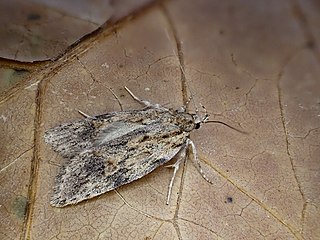
Izatha voluptuosa is a species of moth in the family Oecophoridae. It is endemic to New Zealand. This species is classified as "Not Threatened" by the Department of Conservation.
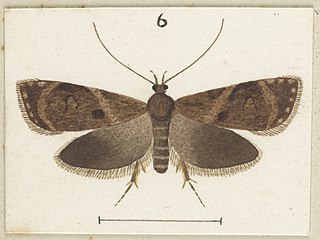
Izatha austera is a species of moth in the family Oecophoridae. It is endemic to New Zealand. The larvae of this species feed on dead wood by tunnelling into branches of its host species. The larvae matures from September and is on the wing in the months of December to January. The adult moth is variable in colouration but is seldom observed.
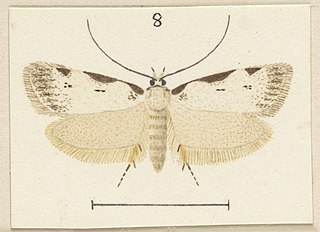
Izatha balanophora is a moth of the family Oecophoridae. It is endemic to New Zealand, where it is widespread in the North Island. Larvae live off the dead bark of kānuka. The adult moths are on the wing during December to March.

Izatha mesoschista is a moth of the family Oecophoridae. It is endemic to New Zealand.
Izatha haumu is a species of moth in the family Oecophoridae. It is endemic to New Zealand. This species is classified as "At Risk, Naturally Uncommon" by the Department of Conservation. It is believed to only inhabit the Aupouri Peninsula.
Izatha quinquejacula is a species of moth in the family Oecophoridae. It is endemic to New Zealand. This species is classified as "At Risk, Naturally Uncommon" by the Department of Conservation. It is only found on the Three Kings Islands.

Izatha huttonii is a moth of the family Oecophoridae. It is endemic to New Zealand, where it is known from the Wellington district of the North Island, the South Island, and Stewart Island. Although similar in appearance to related species I. huttonii can be distinguished as it has a distinctive "M" shaped mark on its forewings. The larvae feed on the dead wood of makomako and karamu. Adult moths have been collected from October to March.
Izatha taingo is a species of moth in the family Oecophoridae. It is endemic to New Zealand. This species is classified as "At Risk, Naturally Uncommon" by the Department of Conservation. It is only known from the Aupouri Peninsula of Northland.
Izatha spheniscella is a species of moth in the family Oecophoridae. It is endemic to New Zealand. This species is classified as "At Risk, Naturally Uncommon" by the Department of Conservation. It is only found on the subantarctic Snares Islands.

Izatha prasophyta is a moth of the family Oecophoridae. It is endemic to New Zealand, where it is known from the North Island, except Hawkes Bay or the Wairarapa. Larvae likely feed on rotting wood although larvae of this species have been reared on the fruiting body of the bracket fungus Bjerkandera adusta. Adults are on the wing from November to February.
Izatha gibbsi is a species moth in the family Oecophoridae. It is endemic to New Zealand. This species is classified as "At Risk, Naturally Uncommon" by the Department of Conservation. It is named for George W. Gibbs.
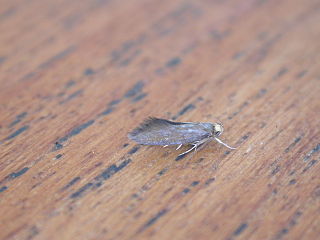
Crassa unitella is a moth of the family Oecophoridae. It is known from most of Europe.
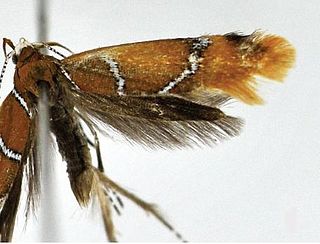
Promalactis is a genus of moths of the family Oecophoridae.

Denisia stipella is a moth of the family Oecophoridae. It is found in almost all of continental Europe, except the Iberian Peninsula and the southern part of the Balkan Peninsula.
Hierodoris sesioides is a species of moth in the family Oecophoridae. It is endemic to New Zealand and is known from its type locality of Esk State Forest in the Hawkes Bay. The host species is Spohora tetraptera, a kōwhai species. The larvae feed internally in woody galls on the stems of this plant. This species is classified as "Data Deficient" by the Department of Conservation.
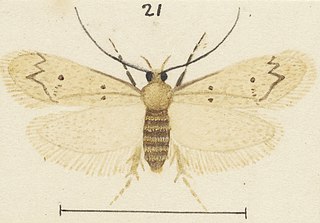
Leptocroca amenena is a moth of the family Oecophoridae first described by Edward Meyrick in 1888. It is endemic to New Zealand. The classification of this moth within the genus Leptocroca is regarded as unsatisfactory and in need of revision. As such this species is currently also known as Leptocroca (s.l.) amenena.

Leptocroca porophora is a moth of the family Oecophoridae first described by Edward Meyrick in 1929. It is endemic to New Zealand. The classification of this moth within the genus Leptocroca is regarded as unsatisfactory and in need of revision. As such this species is currently also known as Leptocroca (s.l.) porophora.
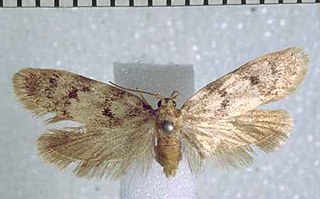
Leptocroca variabilis is a moth of the family Oecophoridae first described by Alfred Philpott in 1926. It is endemic to New Zealand. The classification of this moth within the genus Leptocroca is regarded as unsatisfactory and in need of revision. As such this species is currently also known as Leptocroca (s.l.) variabilis.














